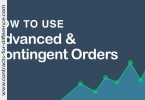One of the most popular orders given to any broker and CFD provider is the limit order. Most share traders may already be familiar with limit orders and these can be used in a similar way with CFDs. Limit orders mean that you are either giving an instruction to buy at or below the current market price or sell at market or a price above. With this type of order you will never pay more than the specified price or sell lower than the specified price. Limit orders can be used in CFD trading when entering a new trade and for closing a trade at a specified upper limit level.
A ‘Limit Order’ is an instrument that is used to execute a trade at a pre-set price. In particular, limit orders serve the purpose of entering the market at a requested level that is at a more favourable price than the current price, with the trade triggered if the mid-price of the live quote reaches the stipulated amount. For example, with the FTSE 100 quoted at 5040-5044 a limit order to buy could be placed at 5020 or a limit order to sell at 5065. These orders may be ‘good for the day’ or ‘good until cancelled’. You can open both long and short positions through using a limit order.
When seeking to lock-in profits on an open long position, a limit order to sell would be placed at a level above current market prices.
CFD Limit Order Workings
You probably know that when you place a simple order with your broker or CFD dealer, it may not be fulfilled at the price you currently see on the brokers website. Prices of financial securities move all the time, so the broker will just buy or sell on the market when he gets your order.
If you don’t like the idea of this, then you can use what is called a limit order. The limit order tells your broker that there is a limit to how much you will pay for something, or how little you want to sell your financial interest for. The broker then has to find some shares or contracts at the price you’re prepared to pay, or he has to find a buyer who will pay you what you want.
Of course, it doesn’t always work out that the broker can find a corresponding party for the deal. This means that, unlike the simple market order, you may find that the deal never goes through, and that you don’t buy or sell those securities as you wish. This is the downside of placing a limit order, and it is your choice whether you can tolerate never taking the trade in return for the assurance of the price you want.
For example, say you wanted to buy shares in company A, which is currently trading at $1.65 per share, but to meet profit objectives you didn’t want to pay more than $1.60. You could simply place a limit order with your broker to buy for $1.60 or better, and then wait to see if it is fulfilled. The order could be Good till Cancelled (GTC) if you are prepared to wait, or you could place it for Today only so that you can find another trade for your money tomorrow if this one does not go through.
This is a good way to control your costs, although it does require you to keep good records of how many open orders you have out there, and the financial commitment involved.
Using Limit Orders for Selling
Limit orders can be used for selling too, but this is a less common device. Usually when you want to sell and close a position, it’s for the reason that you think the security has made its run, and you want to take your profits and use them elsewhere.
Still, if you wanted to sell but were determined not to take less than a certain amount for your financial interest, the sell limit order would work well. A normal stop loss order is a request to sell securities once they breach your specific stop level but such stops are not guaranteed. Suppose a market is swinging violently and right now it is 85p and rallying sharply. You place a stop limit order at 92p (to pick profits) but this does not guarantee you will get 92p when selling if the market breaches the 92p level for one moment (this is especially so if your trade size exceeds the dealing size available in the market at that time) and then retraces rapidly down.
Perhaps the best strategy in this case is to also set a stop limit. Here, you are hoping to receive a greater return than the market is currently offering so you place a limit order at the level you want, but also put a stop loss order below the market price to close the position before you incur big losses. So in conjunction to your 92p stop order, you also place a limit of 83p (for instance). This serves to create a range at which you are willing to sell the shares. Should the shares move below this price range before the trade can be dealt, the stop loss will remain inactive. You simply have to be aware that if the broker cannot get your price then you are left holding the securities, and if the time is right for selling you might find that the value continues to fall. Having said that, should the stock recover and move back into the stop band, then the sell trade will be executed at 92p.







